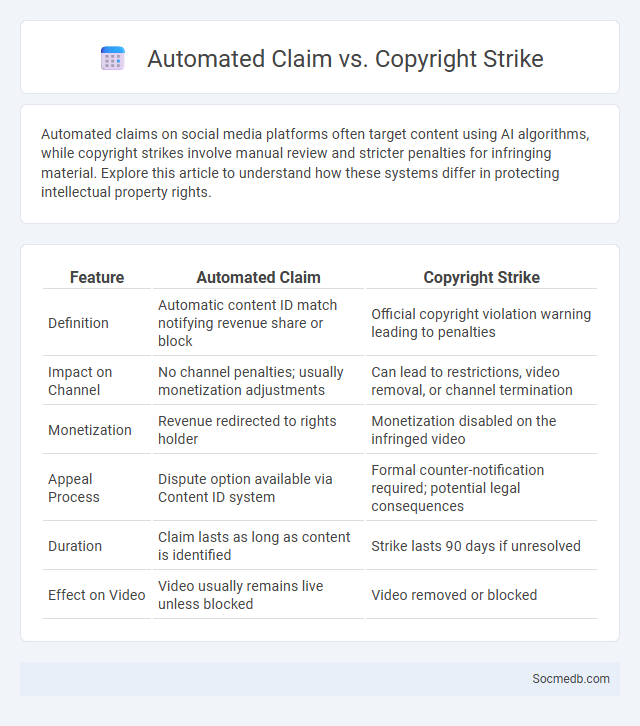
Photo illustration: Automated Claim vs Copyright Strike
Automated claims on social media platforms often target content using AI algorithms, while copyright strikes involve manual review and stricter penalties for infringing material. Explore this article to understand how these systems differ in protecting intellectual property rights.
Table of Comparison
| Feature | Automated Claim | Copyright Strike |
|---|---|---|
| Definition | Automatic content ID match notifying revenue share or block | Official copyright violation warning leading to penalties |
| Impact on Channel | No channel penalties; usually monetization adjustments | Can lead to restrictions, video removal, or channel termination |
| Monetization | Revenue redirected to rights holder | Monetization disabled on the infringed video |
| Appeal Process | Dispute option available via Content ID system | Formal counter-notification required; potential legal consequences |
| Duration | Claim lasts as long as content is identified | Strike lasts 90 days if unresolved |
| Effect on Video | Video usually remains live unless blocked | Video removed or blocked |
Understanding Automated Claims: Definition and Process
Automated claims in social media refer to the use of AI and algorithms to identify and address copyright infringements or content ownership disputes swiftly and accurately. This process involves scanning posts, videos, and images to detect unauthorized use, then automatically generating notifications or takedown requests to protect intellectual property rights. Understanding automated claims helps users navigate content regulations and ensures compliance with platform policies while safeguarding creators' rights.
What is a Copyright Strike?
A copyright strike occurs when a content creator uploads material that infringes on copyrighted works, triggering a formal complaint from the rights holder. Platforms like YouTube enforce these strikes to protect intellectual property, resulting in content removal, channel restrictions, or termination after multiple violations. Understanding copyright strikes is crucial for creators to avoid legal disputes and maintain their online presence.
Key Differences: Automated Claim vs Copyright Strike
Automated claims on social media are generated by content identification systems that detect copyrighted material and often result in ad revenue sharing or video blocking, whereas copyright strikes are formal legal actions that can lead to content removal and account penalties. Automated claims typically do not affect user accounts but limit monetization or visibility, while copyright strikes impact account standing and may cause suspension after multiple infractions. Understanding these distinctions helps content creators navigate platform policies and protect their digital rights effectively.
The Role of Content ID in Automated Claims
Content ID technology plays a crucial role in automated claims by identifying copyrighted material across social media platforms, ensuring intellectual property rights are protected efficiently. This system scans uploaded videos against a database of registered content, enabling rights holders to monetize, block, or track unauthorized use without manual intervention. By streamlining copyright enforcement, Content ID reduces disputes and enhances the accuracy of claim management in the dynamic social media ecosystem.
Legal Implications of Copyright Strikes
Copyright strikes on social media platforms have significant legal implications, often leading to account suspension or content removal under the Digital Millennium Copyright Act (DMCA). Users accused of copyright infringement may face legal actions, including lawsuits for damages, if the strikes are challenged in court. Understanding platform-specific policies and fair use exemptions is crucial to navigate the complexities of digital copyright enforcement.
How to Respond to an Automated Claim
When responding to an automated claim on social media, promptly acknowledge the message to demonstrate active engagement and customer care. Use clear, concise language tailored to the platform's character limits while addressing the specific issue raised by the automated claim. Incorporate relevant keywords like "automated claim resolution," "customer support," and "social media response strategy" to enhance discoverability and optimize engagement.
Steps to Take After Receiving a Copyright Strike
After receiving a copyright strike on social media, immediately review the platform's copyright policy and identify the specific content in violation. Submit a counter-notification if you believe the strike was issued in error, providing detailed evidence to support your claim. To prevent future strikes, regularly monitor content for copyright compliance and consider obtaining licenses for all third-party materials used.
Preventing Automated Claims and Strikes on Your Content
Implement robust anti-bot verification systems to prevent automated claims and strikes on your social media content, ensuring genuine user interactions. Utilize AI-driven monitoring tools to detect and block fraudulent activity in real-time, protecting your account integrity and content ownership. Regularly update platform-specific policies and settings to maintain optimal security against malicious automated attacks.
Frequently Asked Questions: Automated Claims vs Strikes
Automated claims on social media platforms are generated by algorithms detecting potential copyright infringements, often resulting in immediate content removal or monetization restrictions without manual review. Strikes, however, involve a manual review process where content violations are confirmed and users receive formal penalties that can escalate to account suspension after multiple infractions. Understanding the difference between automated claims and strikes is crucial for managing content compliance and avoiding long-term platform restrictions.
Best Practices for Handling Copyright Issues on Digital Platforms
Protecting your content on social media requires understanding copyright laws and promptly addressing infringements by issuing takedown requests or claiming ownership through platform tools. You should always credit original creators when sharing content and use licensed materials to avoid legal complications. Monitoring your digital presence regularly helps maintain control over your intellectual property and ensures compliance with platform policies.
 socmedb.com
socmedb.com